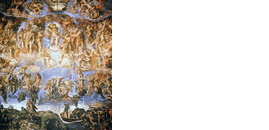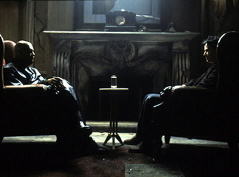
|
|
|
|
|
Class
Prep
|
|
|
|
- The
Matrix
-

- The readings for today's class are about our own modern genre
of the spectacle, cinema, and the role of technology in contemporary
apocalyptic scenarios. Together, they provide frameworks
for exploring the apocalyptic/post-apocalyptic movie, The Matrix,
which we will watch together in class.
-
- Both readings deal with the issue of the dystopias and/or utopias
that technology is thought to provide, and explore the apocalyptic
responses that have been engendered by technological crises (recall
that a crisis is not necessarily a negative event, but rather
simply a change that requires a new response). James
Combs is a political scientist interested in apocalyptic cinema
because its creative enterprise parallels political dynamics. As
you read his chapter from Crisis Cinema, consider the following
issues and questions:
-
-
- What "canons of modernity" have eroded and why?
- How has cinema in general, and apocalyptic cinema in particular, responded to the crisis of this erosion?
- How has the concept of the hero changed in American apocalyptic cinema?
- Combs published his essay in 1993, well before The Matrix
came out. Apply his insights to this movie.
-
- The second reading is John M. Bozeman's essay on technological
millenarianism in the United States. Bozeman addresses
more broadly the promise and threat of technology by looking at
specific technologies and the millenarian responses they generate
(using Wallace's categories of response to crisis). As
you read this piece, think about the following:
-
-
- Do the movements mentioned in the article share any features of leadership? development?
- How did these groups respond to failure?
- In what do these groups place their hopes, and how is this related to Wallace's "responses to crisis"?
- Can you correlate any of Bozeman's insights to The Matrix?
-
-
- Assigned Readings
- Primary: We will watch the movie in class; you may want to rent/review it before or after class as well.
- Secondary: Combs, "Pox-Eclipse Now: The Dystopian
Imagination in Contemporary Popular Movies"; Bozeman,
"Technological Millenarianism in the United States"
(ERes); Daniels 1-18
-
-
- Further Reading
 Baker, Rob. "Veils and Visions: The Apocalypse
According to Wim Wenders." Parabola 23
(1998) 86-90.
Baker, Rob. "Veils and Visions: The Apocalypse
According to Wim Wenders." Parabola 23
(1998) 86-90.
-
- Davis, Erik. Techgnosis: Myth, Magic and Mysticism in the Age of Information. New York: Harmony Books, 1998.
-
- Forshey, Gerald E. "Apocalyptic Mood in Contemporary Films." Explor 4 (1978) 28-38.
-
 Frentz, Thomas S. and Janice Hocker Rushing. "'Mother Isn't Quite Herself Today': Myth and Spectacle in The Matrix." Critical Studies in Media Communication 19 (1 2002) 64-86. Frentz, Thomas S. and Janice Hocker Rushing. "'Mother Isn't Quite Herself Today': Myth and Spectacle in The Matrix." Critical Studies in Media Communication 19 (1 2002) 64-86.
-
- Lindohf, Jessica. "The Ethos of Modern Apocalyptic Stories: The Use of Judaeo-Christian Narrative in Popular Film." In Virtue Ethics and Sociology: Issues of Modernity and Religion (ed. Kieran Flanagan and Peter C. Jupp; New York: Palgrave, 2001) 186-201.
-
- Lindvall, Terry and J. Dennis Bounds. "The Late Great Planet Hollywood: The Apocalyptic Imagination in Popular Film." Christianity and the Arts 6 (1999) 31-4.
-
 Ostwalt, Conrad E., Jr. "Hollywood and Armageddon: Apocalyptic Themes in Recent Cinematic Presentation." In Screening the Sacred: Religion, Myth, and Ideology in Popular American Film (ed. Joel W. Martin and Conrad E. Ostwalt, Jr.; Boulder, Colorado: Westview, 1995) 55-63, 164-5.
Ostwalt, Conrad E., Jr. "Hollywood and Armageddon: Apocalyptic Themes in Recent Cinematic Presentation." In Screening the Sacred: Religion, Myth, and Ideology in Popular American Film (ed. Joel W. Martin and Conrad E. Ostwalt, Jr.; Boulder, Colorado: Westview, 1995) 55-63, 164-5.
-
- Schuchardt, Read Mercer. "The Matrix." Re:generation Quarterly 5 (Summer 1999) 38-39.
-
 Sharrett, Christopher, ed. Crisis Cinema: The Apocalyptic Idea in Postmodern Narrative Film,
PostModernPositions 6. Washington, D. C.: Maisonneuve, 1993.
Sharrett, Christopher, ed. Crisis Cinema: The Apocalyptic Idea in Postmodern Narrative Film,
PostModernPositions 6. Washington, D. C.: Maisonneuve, 1993.
-
 Strug, Cordell. "Apocalypse Now What? Apocalyptic Themes in Modern Movies." Word and World 15 (1995) 159-65.
Strug, Cordell. "Apocalypse Now What? Apocalyptic Themes in Modern Movies." Word and World 15 (1995) 159-65.
-
 Žižek, Slavoj. The Matrix; Or, Malebranche in Hollywood." Philosophy Today 43 (1999) 11-26.
Žižek, Slavoj. The Matrix; Or, Malebranche in Hollywood." Philosophy Today 43 (1999) 11-26.
-
- See also the section of the Course Bibliography on Contemporary Media & Apocalyptic Themes.
-
-
- Links
-
-
-
- Sources
- Photograph:
|
|
|
|
|
